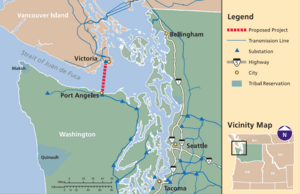Juan de Fuca Cable Project facts for kids
Quick facts for kids Juan de Fuca Cable Project |
|
|---|---|

Map of Juan de Fuca Cable Project
|
|
| Location | |
| Country | Canada–United States |
| State | Washington |
| Province | British Columbia |
| From | Victoria, British Columbia 48°29′26″N 123°27′30″W / 48.49056°N 123.45833°W |
| Passes through | Strait of Juan de Fuca |
| To | Port Angeles, Washington 48°06′10″N 123°25′00″W / 48.10278°N 123.41667°W |
| Ownership information | |
| Owner | Sea Breeze Pacific Juan de Fuca Cable LP |
| Operator | BC Hydro/Bonneville Power Administration |
| Construction information | |
| Manufacturer of conductor/cable | ABB "HVDC Light" |
| Manufacturer of substations | ABB |
| Expected | 2020? |
| Technical information | |
| Type | Buried lines Submarine cables |
| Type of current | HVDC |
| Total length | 22 mi (35 km) |
| Power rating | 550 MW |
| DC voltage | 150 kv |
| No. of poles | 0 |
The Juan de Fuca Cable Project is a plan to build a large underwater power cable. This cable would connect Vancouver Island in British Columbia, Canada, with Port Angeles, Washington in the United States. It's designed to carry a lot of electricity, about 550 megawatts (MW).
The main part of the cable would run for about 19 miles (30 kilometers) under the Strait of Juan de Fuca. This project aims to help share electricity between the two countries.
Contents
What is the Juan de Fuca Cable Project?
This project is all about creating a new way to move electricity. It involves laying a special type of power line called a high-voltage direct current (HVDC) cable. This cable would be buried underground on land and then placed on the seabed underwater.
The company proposing this project is called Sea Breeze Pacific Juan de Fuca Cable LP. They want to create a strong link between the power grids of Canada and the United States.
How Does the Cable Work?
The cable uses high-voltage direct current (HVDC) technology. This is a very efficient way to send large amounts of electricity over long distances, especially underwater.
- Converter Stations: To make this work, two special buildings called converter stations would be built.
- One station would be in Port Angeles, Washington, next to an existing power station.
- The other would be near Victoria, British Columbia, at the Pike Lake substation.
- Changing Electricity: These stations change the type of electricity. Power grids usually use alternating current (AC). The converter stations change AC power into DC power for the cable. At the other end, they change it back from DC to AC so it can be used by homes and businesses.
Why is This Project Important?
This power cable would bring several benefits to both Canada and the United States.
- Sharing Power: It would allow the two countries to share electricity more easily. This is helpful when one area has extra power and another needs more.
- Renewable Energy: The cable would help make renewable energy sources more stable. Things like wind, hydro (water), and solar power can change a lot depending on the weather or time of year. This cable would let areas with lots of wind or hydro power share it with places that need it. This means less energy is wasted.
- Less Congestion: Imagine a busy highway; sometimes, power lines get "congested" or too full. This new cable would help relieve that congestion, making the power grid run smoother.
- Columbia River Treaty: The United States has an agreement with Canada called the Columbia River Treaty. Because Canada helps manage the Columbia River, the U.S. is supposed to send some electricity back to British Columbia. This cable would make it easier to fulfill that agreement.
Where Does the Project Stand Now?
The idea for the Juan de Fuca Cable Project has been around for a while.
- Approvals: In 2007, the project completed a big study called an environmental impact statement. This study checks how the project might affect the environment. In 2008, the U.S. government gave a special permit for the project.
- Future Steps: As of late 2013, the project was waiting for a final agreement to sell power to BC Hydro, a Canadian power company. It also needed new approval from Canadian energy regulators.
If built, this would be the third major HVDC system in the Pacific Northwest. The other two are the Pacific DC Intertie and HVDC Vancouver Island.

